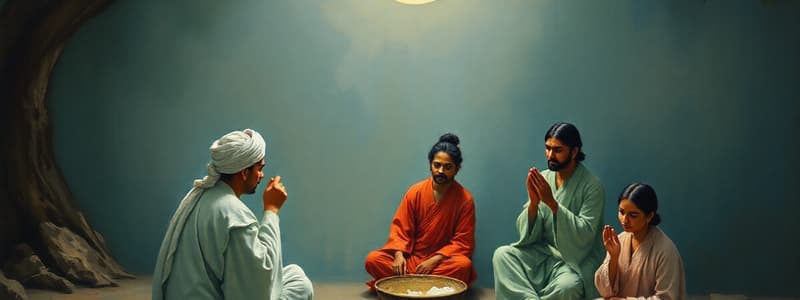Podcast
Questions and Answers
What is the primary purpose of chanting the Daimoku, as practiced by Nichiren Buddhists?
What is the primary purpose of chanting the Daimoku, as practiced by Nichiren Buddhists?
- To provide musical accompaniment to religious ceremonies.
- To invoke divine intervention for personal well-being.
- To achieve a state of trance through rhythmic repetition.
- To publicly declare allegiance to a specific Buddhist scripture. (correct)
Which aspect of music is most emphasized in the Baul tradition of Bengal?
Which aspect of music is most emphasized in the Baul tradition of Bengal?
- Its aesthetic beauty and elaborate melodic structures.
- Its role in communal gatherings and festivals.
- Its capacity to facilitate direct spiritual connection. (correct)
- Its function as a historical record of religious teachings.
The Sema ceremony, central to the Mevlevi order, is primarily intended to facilitate:
The Sema ceremony, central to the Mevlevi order, is primarily intended to facilitate:
- the memorization of theological texts through rhythmic movements.
- the public performance of Sufi poetry and musical compositions.
- the historical reenactment of Mevlâna Jalaluddin Rumi's teachings.
- a meditative state of worship through song and dance. (correct)
In the context of national anthems, such as that of the South African women's hockey team, what is their main function at public events?
In the context of national anthems, such as that of the South African women's hockey team, what is their main function at public events?
What distinguishes waiata and karakia in Māori culture from other musical forms mentioned?
What distinguishes waiata and karakia in Māori culture from other musical forms mentioned?
Which of the following best contrasts the use of music in Daimoku chanting and Mevlevi whirling?
Which of the following best contrasts the use of music in Daimoku chanting and Mevlevi whirling?
How does the transmission of songs in the Baul tradition differ from the creation of Mevlevi music by composers like Dede Efendi?
How does the transmission of songs in the Baul tradition differ from the creation of Mevlevi music by composers like Dede Efendi?
What is a key difference in the intended audience and context between national anthems and the religious music traditions described?
What is a key difference in the intended audience and context between national anthems and the religious music traditions described?
Which of these musical traditions places the strongest emphasis on the personal and emotional relationship with the divine?
Which of these musical traditions places the strongest emphasis on the personal and emotional relationship with the divine?
Flashcards
Daimoku
Daimoku
A chant by Nichiren expressing the Secret Laws of Buddhism.
Bauls of Bengal
Bauls of Bengal
Traveling religious minstrels from India focusing on personal god through music.
Mevlevi Dancers
Mevlevi Dancers
Sufi Muslim performers who worship through song and whirling dance.
Sema Ceremony
Sema Ceremony
Signup and view all the flashcards
National Anthems
National Anthems
Signup and view all the flashcards
Māori Waiata
Māori Waiata
Signup and view all the flashcards
Karakia
Karakia
Signup and view all the flashcards
Lotus Sutra
Lotus Sutra
Signup and view all the flashcards
Dede Efendi
Dede Efendi
Signup and view all the flashcards
Study Notes
Daimoku, 1253, Nichiren
- The 13th-century Japanese Buddhist sage Nichiren developed a chant, Daimoku.
- The chant is said to express "Secret Laws."
- The phrase Namu myōhō renge kyō is chanted without musical accompaniment for extended periods.
- This practice reflects commitment to the Lotus Sutra.
Bauls of Bengal, 19th Century, India
- Bauls are traveling religious minstrels, predominantly from Bangladesh and West Bengal.
- They believe in spiritual power through music.
- Songs, often passed verbally, express loving relationships with personal gods.
Mevlevi Dancers, 13th Century, Turkey
- Also known as whirling dervishes, these modern dancers are Sufi Muslims following Mevlâna Jalaluddin Rumi’s teachings.
- Their worship of God involves Sema ceremonies, combining song and dance.
- 18th-century Turkish composer Dede Efendi composed significant Mevlevi music.
Māori Singers, 1992, The Cook Islands
- Māori use waiata (songs) and karakia (prayers/chanting) for celebrations, entertainment, prayers, and conveying their feelings.
- Waiata and karakia are used in traditional events.
National Anthems, 2022, Women's International Hockey
- Each country has a special song played for important events like sports competitions or dignitaries’ arrival.
- The South African women's hockey team sang their national anthem before the Wales match in Cardiff in July 2022.
Studying That Suits You
Use AI to generate personalized quizzes and flashcards to suit your learning preferences.

